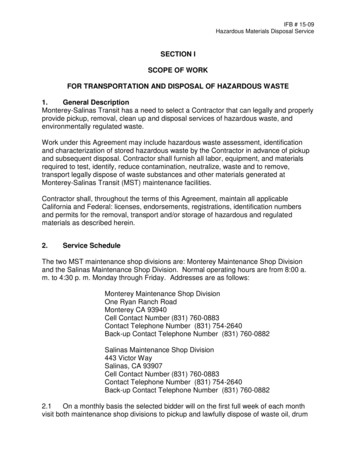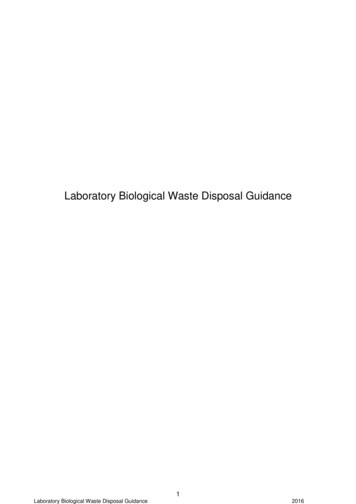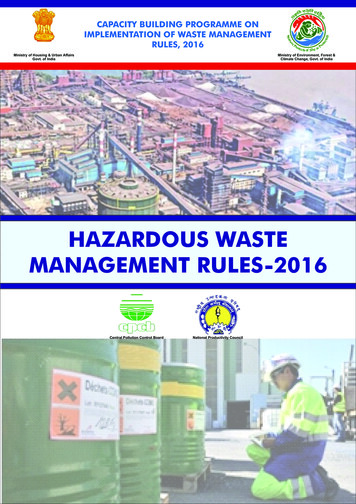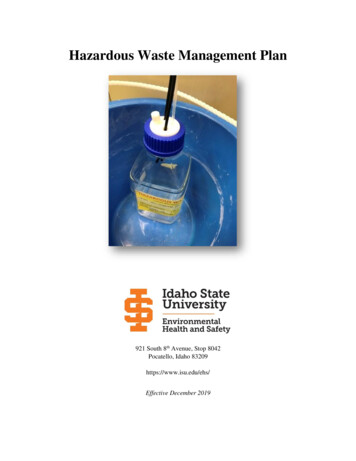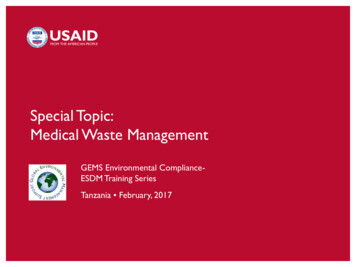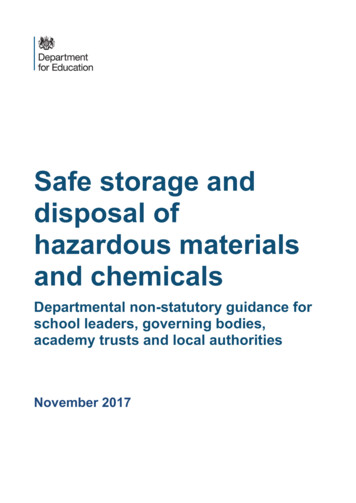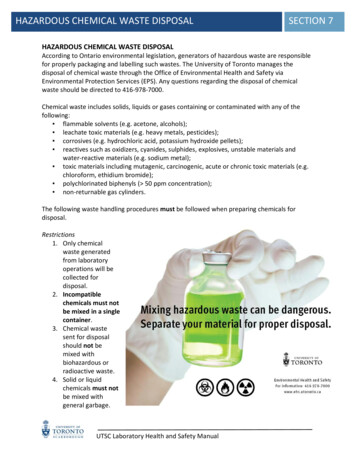
Transcription
HAZARDOUS CHEMICAL WASTE DISPOSALSECTION 7HAZARDOUS CHEMICAL WASTE DISPOSALAccording to Ontario environmental legislation, generators of hazardous waste are responsiblefor properly packaging and labelling such wastes. The University of Toronto manages thedisposal of chemical waste through the Office of Environmental Health and Safety viaEnvironmental Protection Services (EPS). Any questions regarding the disposal of chemicalwaste should be directed to 416‐978‐7000.Chemical waste includes solids, liquids or gases containing or contaminated with any of thefollowing: flammable solvents (e.g. acetone, alcohols); leachate toxic materials (e.g. heavy metals, pesticides); corrosives (e.g. hydrochloric acid, potassium hydroxide pellets); reactives such as oxidizers, cyanides, sulphides, explosives, unstable materials andwater‐reactive materials (e.g. sodium metal); toxic materials including mutagenic, carcinogenic, acute or chronic toxic materials (e.g.chloroform, ethidium bromide); polychlorinated biphenyls ( 50 ppm concentration); non‐returnable gas cylinders.The following waste handling procedures must be followed when preparing chemicals fordisposal.Restrictions1. Only chemicalwaste generatedfrom laboratoryoperations will becollected fordisposal.2. Incompatiblechemicals must notbe mixed in a singlecontainer.3. Chemical wastesent for disposalshould not bemixed withbiohazardous orradioactive waste.4. Solid or liquidchemicals must notbe mixed withgeneral garbage.UTSC Laboratory Health and Safety Manual
HAZARDOUS CHEMICAL WASTE DISPOSALSECTION 75. Liquid chemical wastemust not be flushed downdrains as a method ofdisposal. This practice isillegal and may lead todangerous reactions anddamage to the drainsystem as well as create apotential hazard toFacilities personnelworking on the system.6. The waste generator bears the primary responsibility for proper packaging and labelling.Any hazardous waste that is improperly packaged or labelled will not be removed.7. If the individual overseeing the collection has any doubts about proper labelling orpackaging techniques, the waste will note be removed until he/she is satisfied.8. Waste materials must be labelled and packaged in a manner that will allow them to bestored or transported without the danger of spillage, explosion or hazardous vapoursescaping.9. Materials requiring special handing include organic peroxides, PCBs (polychlorinatedbyphenyls) and explosives. Before disposing these materials, consult EnvironmentalProtection Services at 416‐978‐7000 or email hazwaste.ehs@utoronto.ca.Containers1. All containers for storing chemical waste must beproperly sealed and undamaged.2. Any container not properly sealed will not be removed(corks or rubber stoppers are not recommended for acidbottles).3. Liquid waste containers should only be filled to 70‐80%capacity to allow for vapour expansion and to minimizethe potential for spills from overfilled containers.4. Container material must be compatible with the storedhazardous waste (e.g. sharps must be in puncture‐resistant containers, hydrofluoric acid cannot be stored inglass containers).5. Promptly dispose of aging containers. Some chemicalsare time sensitive and may degrade into very hazardousby‐products (e.g. ethers may degrade to form explosiveorganic peroxides).Labels1. To prevent the mixing of incompatible hazardous wastes,all materials must be clearly identified by Chemical WasteLabels provided by Environmental Protection Services.UTSC Laboratory Health and Safety Manual
HAZARDOUS CHEMICAL WASTE DISPOSALSECTION 72. The following information must be provided:a) the generic names of the components in the container along with approximatepercentages of each component present (no abbreviations or trademark names areto be used);b) the general toxicity and hazard description;c) building name, room number and individual to contact.3. If the waste is not properly identified, the containers will not be removed.Storage of Waste Chemicals1. If possible, waste chemicals should be stored in the central waste holding facility oncampus located in the shipping and receiving area of the Science Wing (SW111).2. Waste is to be transported to the central storage area using proper procedures fortransporting chemicals.3. All safety precautions required for the handling and storage of chemicals must also beobserved with chemical waste.4. Waste should be segregated according to compatibility groups such as acids, bases,flammables, oxidizers, and water reactives, and NOT according to alphabetical order.Scheduling Waste Collection1. The individual in charge of the central waste holding facility is responsible for schedulingthe waste collection.2. If chemical waste is being stored in individual laboratories, it is the responsibility of thelaboratory supervisor to schedule a waste collection.3. Chemical waste collection is arranged through EPS at 416‐978‐7000.4. Chemical waste must not accumulate. The frequency of collection is dependent on thetype and amount of waste generated.For more information, please go to: OLOGICAL WASTE DISPOSALAll laboratories that work with potentially hazardous biological agents and materials, andgenerate waste containing such agents are responsible for the separation, packaging, andtreatment of their laboratory waste prior to its removal and disposal.For more information, go to: http://www.ehs.utoronto.ca/resources/wmindex/wm5 1.htmRADIOACTIVE WASTE DISPOSALRadioactive waste activities are carried out under a Canadian Nuclear Safety Commission(CNSC) Waste Management Facility licence. All radioactive waste, except liquid scintillationcounting vials, is either shipped to a facility for disposal or held for decay. Liquid scintillationcounting vials are shipped to a radioactive waste broker.For more information, go to: http://www.ehs.utoronto.ca/resources/wmindex/wm5 3.htmUTSC Laboratory Health and Safety Manual
HAZARDOUS CHEMICAL WASTE DISPOSALSECTION 7SEGREGATION OF CHEMICAL WASTEChemical waste should be stored according to the following groupings based on chemicalreactivities. Figure 1 may be used to assist in classifying chemical waste. For any waste thatcannot be classified according to these groups, Environmental Protection Services should beconsulted at 416‐978‐7000.Group A – Inorganic Acids and Acid Saltsa) All inorganic acids (e.g. sulphuric, hydrochloric).b) All compounds which do not liberate a gas when acidified (e.g. ferric chloride, sodiumsulphate).c) Inorganic solids which are inert (e.g. silica).Note: Perchloric acid, although an inorganic acid, is a powerful oxidizing agent and should beincluded in Group E.Group B – Nitrogenated Bases, Caustics and Acid‐Reactive Compoundsa) Organic and inorganic bases (e.g. amines, sodium hydroxide).b) Elements and inorganic salts that may react with acids to liberate gaseous products (e.g.potassium cyanide, ferric sulphide).Group C – Neutral Organic Solidsa) All solid organic compounds which are neutral – no acids or bases (e.g. carbon black,styrene).Group D – Flammable Liquids, Halogenated Solvents and Organic Acidsa) All organic liquids excluding bases (e.g. toluene, chloroform).b) Organic acids (e.g. formic acid, acetic acid).Group E‐ Oxidizersa) Any inorganic compound may start or increase the intensity of a fire (e.g. hydrogenperoxide, lead nitrate).Group F – Pesticidesa) Any compounds used to destroy or inhibit plant or animal pests such as pesticides,fungicides, insecticides, etc.Group Specials – Water and Reactive Materialsa) All chemicals which react with air and/or water, including fuming substances (e.g.sodium – a water reactive, phosphorus – an air reactive, lithium aluminum hydride –both air and water reactive, and phosphorus tribromide – fuming substance).UTSC Laboratory Health and Safety Manual
HAZARDOUS CHEMICAL WASTE DISPOSALSECTION 7CHEMICAL INCOMPATIBLITIESWhen preparing chemical waste for disposal, it is the generator’s responsibility to ensure thatincompatible chemicals are not stored in the same container. A few general examples are:a) Oxidizers (Group E) should never be mixed with reducing agents (e.g. water‐reactivechemicals such as sodium) or organic materials (Groups B, C and D).GROUP E MUST BE KEPT AWAY FROM GROUPS B, C & Db) Acid‐reactive compounds (Group B) which liberate gaseous products when acidifiedshould not be mixed with any acid (Groups A and E).GROUP B MUST BE KEPT AWAY FROM GROUPS A & Ec) Organic acids (Group D) should be segregated from inorganic acids (Group A). Generallyinorganic acids are oxidizing agents while some organic acids may be either reducingagents or combustible.GROUP D MUST BE KEPT AWAY FROM GROUPS A & EOnce the waste has been classified according to their chemical groups, it must be properlysegregated to minimize the risk of mixing incompatible groups.UTSC Laboratory Health and Safety Manual
HAZARDOUS CHEMICAL WASTE DISPOSALSECTION 7Figure 1: Classification of Chemical Waste for Purpose of SegregationChemical WasteSet Apart(Waste TreatedDifferently)ExplosiveYesNoAir or Water ReactiveYesGroup SpecialsNoOxidizerGroup EYesNoAcidicNeutralOrganicInorganicGroup DGroup AGroup FOrganicYesBasicInorganicSolidLiquidPesticideGroup DNoGroup CUTSC Laboratory Health and Safety ManualLiberatesGaseous ProductsWhen AcidifiedNoGroup AGroup BYesGroup B
disposal of chemical waste through the Office of Environmental Health and Safety via Environmental Protection Services (EPS). Any questions regarding the disposal of chemical waste should be directed to 416‐978‐7000. Chemical waste includes solids, liquids or gases containing or contaminated with any of the following:
